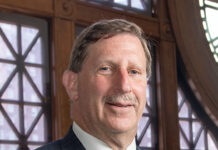Caroline Bertram is a sports concussion physical therapist at University Orthopedics’ new Sports Concussion Rehabilitation Center. Holding a doctorate of physical therapy degree, Bertram specializes in the treatment of concussions. She has worked with players from the Providence Bruins, Brown University athletes, as well as many other student-athletes in Rhode Island. She discusses the symptoms of concussions, their dangers and the services offered at the Sports Concussion Rehabilitation Center.
PBN: How common are sports-related brain injuries today?
BERTRAM: The research on the incidence of concussion is unfortunately limited. I can say that based on a 2016 study in pediatrics, there was an estimated 1.1 million to 1.9 million sport- and recreation-related concussions in the United States in people who were 18 years of age or younger.
Typically, we see the risk of concussion from sport increase in children that are older, whereas younger children tend to sustain concussions through other means such as a fall. The problem is that there is currently no truly objective way to diagnose a concussion, leading to the diagnosis of concussion going based on subjective report.
Unfortunately, underreporting of symptoms or denial of symptoms can be common after a concussion. As a result, any data that we do have is likely to be limited. This is why it is important that we continue to try to learn as much as we can about these head injuries and try to determine a more objective manner of diagnosing them.
PBN: What are some of the symptoms of a concussion, and what are the short-term and long-term consequences?
BERTRAM: Symptoms of a concussion can include headache, dizziness, nausea, light sensitivity, noise sensitivity, changes in mood or behavior, loss of balance, confusion, or changes in memory. Not all of these symptoms show themselves in every concussion, and symptoms can appear immediately or several hours to a day later.
The consequences vary and I think it is important to mention again that research continues to be developed on concussions. We know that short-term consequences include loss of time in school or work, reduction in social participation, including sports. Persisting symptoms of memory loss, confusion, vision troubles, headaches and dizziness can impact any part of a person’s daily life.
Long-term consequences are still not entirely clear, however I know from my clinical experience that sometimes people can have symptoms that persist for years beyond their injury, especially if it is not treated properly to begin with.
PBN: What does treatment for concussed patients look like? What role does physical therapy play in recovery?
BERTRAM: As we learn more about concussions, we are learning that what we call an active recovery is beneficial. We recommend fully resting for the first 24-48 hours after the concussion, which is typically when the symptoms are the most severe. After the first 24-48 hours, we encourage activities that are safe activities that the person would usually participate in.
Until concussion symptoms are gone, the individual must remain out of any activities that significantly increase their risk of sustaining another head injury. This includes contact sports, ball sports, and any activities that require wearing a helmet. Daily activities that we encourage can include reading, working on a computer, playing games, or even trying school or work activities. That being said, all activities should be symptom limited. Having a slight increase in symptoms is OK, but anything above a point or two on a 10-point pain scale indicates that the person should stop the activity.
Physical activity is also strongly encouraged, as long as it is safe. We recommend light cardiovascular activity such as walking or stationary biking, once again limiting the amount and intensity based on symptoms.
Physical therapists play a very important role in recovery from concussion. We are at the forefront of facilitating the active recovery. We can help a person wean back into their daily activities as appropriate and provide symptom management strategies. Physical therapy has been shown to reduce symptom burden in patients after a concussion, making them feel better sooner.
Physical therapists are able to determine the contributing factors to persistent symptoms, including headaches, dizziness and even poor concentration, memory problems and light sensitivity. Many of these problems after a concussion can be linked to a person’s vision, vestibular (balance) system, or even their neck. We can find the source of the problem and treat it appropriately. We also play a large role in exercise prescription.
At the Sports Concussion Rehab Center, I work with a lot of athletes at the high school, college and professional level. Building an exercise tolerance is very important for this population and can be tricky to do properly after a concussion. My job is to help them maintain their cardiovascular fitness as their brain heals.
PBN: What services does University Orthopedics’ new Sports Concussion Rehabilitation Center offer?
BERTRAM: University Orthopedics’ new Sports Concussion Rehabilitation Center provides a more streamlined approach to concussion care. I work with three great doctors that are here to manage care after concussion, facilitate symptom management, and the return to learn and return to play procedures. There is also Kate Wilks, an athletic trainer who works at the high school level and is a great resource to help facilitate treatment of the concussed student-athlete and is a great liaison between the concussion center and athletic trainers at a student’s school.
Then, the center has me, a physical therapist who focuses solely on concussion treatment. I get referrals directly from the doctors to help manage both acute and chronic cases, to facilitate reduction in symptom burden and return to play as appropriate.
A multidisciplinary approach is very important when treating concussions. By having a team working together at University Orthopedics, communication about patient care is much easier, making the treatment of the patients more successful.
PBN: Are there measures that can be taken to prevent concussions from happening?
BERTRAM: If I am being entirely honest, this is a difficult question to answer. Concussions can happen from a hit to the body or a hit to the head. This is because a concussion occurs from the brain shearing against the skull or even physically knocking against the skull. The head does not have to be physically hit for this to happen. This has made it difficult to figure out the best way to completely prevent concussions.
That being said, there are ways to reduce the risk of sustaining a concussion. One of the big ones is by wearing a helmet in activities that warrant one. This does not only include contact sports such as football, hockey, or lacrosse, but also includes wearing a helmet when riding a bike, skiing, snowboarding, or rock climbing.
Other things that can help are proper training in the specific sport that a person wants to play, such as learning how to take a hit appropriately in football and learning how to properly head the ball in soccer. Contact sports are often seen as the main culprit of concussion. The reality is that a concussion can be sustained from any activity. I have seen concussions happen to athletes that play multiple contact sports, however they sustained their concussion by means completely unrelated to these sports.
That being said, the more activities you partake in that are high risk, the more you increase your risk of sustaining a concussion. Activities and sports are important to be a part of, especially for kids. My best advice is to wear a good, certified helmet when you know you should, be well versed in the sport you want to play, and at the very least be cognizant of the number of high-risk activities that you take part in.
Claudia Chiappa is a PBN staff writer. You may contact her at Chiappa@PBN.com.













